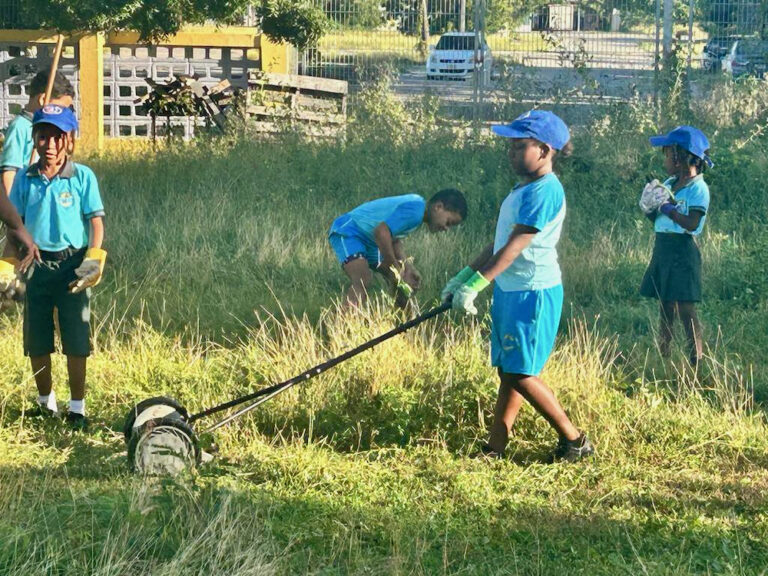Maintenance Tips & Tricks for the school garden
Packing up the school garden for the summer break can reduce problems such as pests and soil erosion for the next season. This summer break can be just as important to the garden as it is to you and the kids!
After a wonderful school garden season filled with bountiful vegetable harvests and skilled building techniques, it’s time for the vegetable garden to take a break.
In order to prevent soil erosion, pests problems and reduce the loss of important nutrients, you have to make sure you prep the school garden for its summer break.
The Caribbean climate isn’t suitable to grow all vegetables all year round, so early summer is a good time to start talking to your students about packing up the garden for the summer holiday.
By following these tips, you can help keep your school garden healthy and beautiful throughout the year. So, roll up your sleeves and get ready to enjoy the fruits (and vegetables) of your labor!

Take care of the garden friends – the good, the bad and the ugly
In this (sub-) tropical climate we tend to eliminate insects like aphids and ants as they appear on ‘our’ plants, in ‘our’ garden. have you ever considered that they too have to survive the heat and drought of the summer? Even the fungi that might have appeared on your plants during the garden season have a survival strategy! What a great way for you students to explore the survival mechanisms of these insects and fungi during a biology lesson!
In order to take care of the, for the next batch of plants, harmful insects and fungi, it is important to remove the dead plants.
But the ‘good bugs’ will need some assistance in surviving, and the best way to assist these garden friends is to apply mulch onto the clean garden bed.
In the mulch the insects will burrow themselves to keep cool and have their summer break in style.

Removing dead plants
The hardest part of prepping the school garden for the summer break must be removing the annual plants. There are always those that are showing some growth potential, even though they have been harvested before. The ones with the little green leaves peeping through, even those have to go. Remember the survival strategy of the fungi and the not-so-nice insects? If you don’t want them to return next school year, you have to clear the patch.
Depending on the level of ‘infestation’ you can decide to dump the plants as a starter for the next compost pile, if there is just too much infestation, or you rather don’t want to run the risk, just bag it and drop it off at your local compost heap or the local organic material dump.
Adding mulch – Cover bare soil
So now that the patch is clear of plant debris, it’s time to shield your garden bed from the harsh Caribbean summer sun. The soil that is left bare needs protection so that it can generate the important nutrients and have a proper, well deserved rest. As the sun beats down on the soil it can dry it out even more, making the top layer vulnerable to be swept away by the wind that can pick up during this time of the year. Don’t forget about the cloudbursts that can develop over land during this change of season. The cloudbursts, in which more than 20ml can fall within a few minutes, can cause the dried topsoil to erode, the entire raised bed can flood and oversaturate, spilling all those essential nutrients.
In order to protect the soil, you need to cover the cleared school garden beds with a thick layer of mulch. Ideally, before adding the mulch, you would divide the compost collection from the previous school garden year and then the layer of mulch.
If it’s your first school garden year, don’t worry about the compost, just add some mulch. Mulch is mostly made of organic material and can come in a variety of forms. In our Caribbean school gardens we like to make our mulch by using wood chips, dried grass or straw, and leaves. At times we also add other organic materials such as newspaper and manure to the mulch.
Irrigation for the evergreens and fruit trees and shrubs
Before you pack your bags for your own summer break, please check up on the irrigation of your school garden. Make sure that the drip system is in place, the droppers are set to minimal dripping for the raised beds and average for the evergreens such as the lemon grass and ‘oregano’ (the type of lemon balm), our tea leaves.
When your school garden had any fruit bearing trees or shrubs, you should check the watering system as well as give them a final general health check before you go.
At the base of the trunk or shrub you might want to add an extra bit of mulch, just to ensure the roots will stay moist during most of the summer heat.
Don’t forget the small bits
After spending an entire school year, about 9 months, in and out the school garden there is a lot of small ‘stuff’ that needs organising and prepped for the next school year.
Gather all the seedling starters and brush them clean of any dirt, and check them for any flaws. most of the seedling starter pots are durable enough to run a few rounds, if they show any cracks please dispose them in the appropriate recycling containers. The remaining starters can be stored in the seedling stations. Make sure that these too are clear of dirt and ready to rumble for the next school garden season. Before you go, also check the spray bottles, make sure they’re empty and place them upside down near the seedling stations. If you have a seed library, make sure the packets are sealed and clearly marked. Depending on where your school garden storage is, you might want to keep the seeds in the fridge during the summer break, this way you get to keep them safe from any rodents or such.
Now you and the school garden can start your well deserved break! And remember to have fun!
Excited to start a school garden with kids?
Discover funding opportunities, explore resources and feel free to ask us questions!
